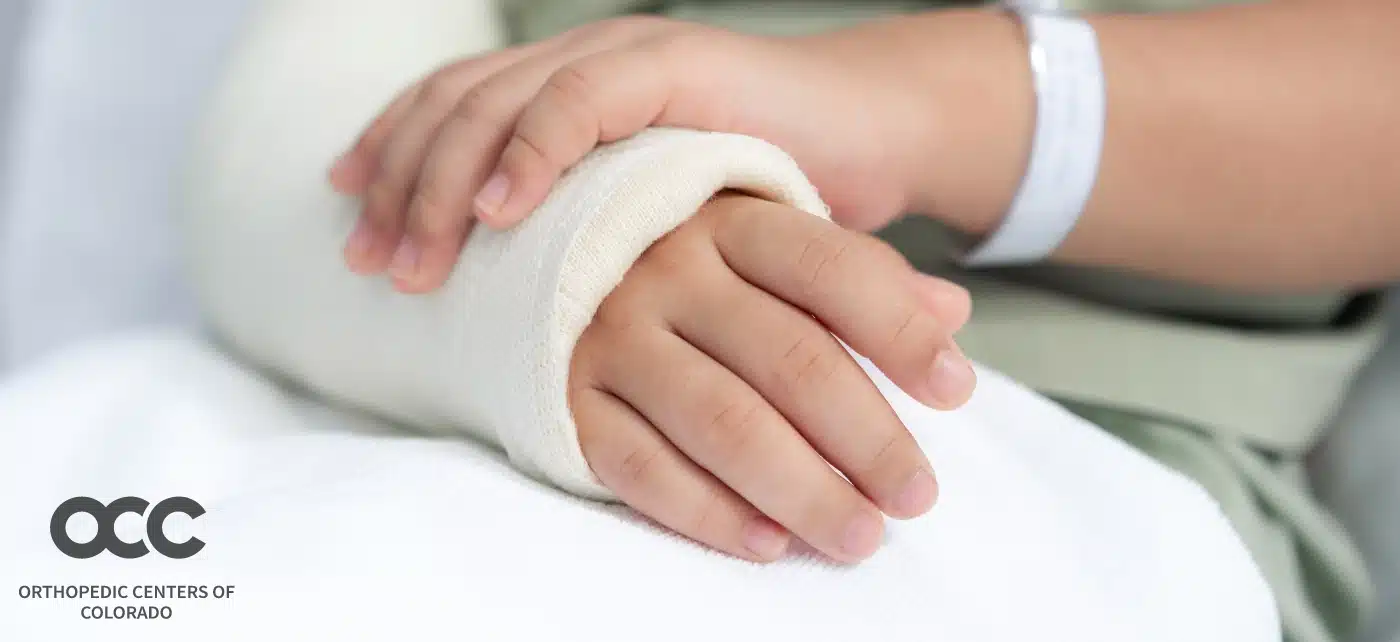A distal radius fracture, often known as a “broken wrist, ” can result in complications that can have long-lasting effects if not treated immediately by an orthopedic specialist. There are two types of distal radius fractures, and one can be an extremely painful and serious injury. Your first and safest start to treatment would be to see one of the experienced surgeons at Advanced Orthopedic & Sports Medicine Specialists in Denver, Parker, and Aurora, Colorado.
OVERVIEW
The radius is one of two forearm bones and is located on the thumb side. The part of the radius connected to the wrist joint is called the distal radius. When the radius breaks near the wrist, it is called a distal radius fracture. Distal radius fractures are a common presentation to emergency departments and urgent care centers and are among the most common injuries seen in an adult orthopedic practice. They account for 25% to 50% of all broken bones. Fractures occur primarily in young adults and people over age 65, with a high incidence in women over age 50.
ABOUT THE WRIST
The wrist is among the most complex joints in the body. The bones in and around the wrist consist of the forearm bones, carpal bones, and hand bones. There are two long bones in the forearm that run from the elbow to the wrist: the larger bone, the radius, and a smaller bone, the ulna, on the little finger side. There are several sets of joints in and around the wrist. These joints vary in type and have different motions:
- The distal radioulnar joint is in the wrist but doesn’t include the wrist bones. It connects the bottom ends of the radius and ulna. This joint allows for rotation of the forearm. The ulna stays in a stable position while the radius rotates around it.
- The radiocarpal joint is where the radius connects with the bottom row of wrist bones. This is the main joint of the wrist. The radiocarpal joint is a condyloid joint. A condyloid joint allows combined motions in multiple planes, including backward and forward bending motions, side-to-side motions, and circular motions.
- The midcarpal joint has features of both condyloid and gliding joints. Gliding joints allow the bones to glide up and down, left and right, and diagonally. The midcarpal joint performs up-and-down and side-to-side movements and works together with the radiocarpal joint to move the wrist.
WHAT IS A DISTAL RADIUS FRACTURE?
Most wrist fractures are the result of a break in the radius bone at the radiocarpal joint—known as a distal radius fracture. The most common location for a distal radius fracture is about one inch from the wrist. The break can take place at different angles and unequal amounts of dislocation. The three prominent types of distal radius fractures are:
- Colles Fracture. A Colles fracture may result from direct impact to the palm, like when using the hands to break up a fall and landing on the palms. The side view of a wrist after a Colles fracture is called a “dinner fork deformity” compared to the shape of a fork facing down. There is a distinct “bump” in the wrist similar to the neck of the fork. It happens because the broken’ end of the distal radius shifts up toward the back of the hand. Colles fractures represent about 90% of all distal fractures.
- Smith’s Fracture. This is almost always caused by a strike or collision to the back of the wrist, as expected when falling backward or on a bent wrist. The end of the radius is displaced or angled in the direction of the palm of the hand. It accounts for about 5% of all radial and ulnar fractures combined.
- Barton’s Fracture. The most common cause of this fracture is a fall on an outstretched wrist. It is a compression injury that extends well into the wrist joint. An MRI is often needed to rule out any damage to the ligaments or soft tissues at the wrist.
CAUSES
The most common mechanism of injury in a distal radius fracture is a fall onto an outstretched hand (FOOSH) with the wrist in extension. It can also happen in a car accident, a bike accident, a skiing accident, or other sports activities. Individuals who suffer from a bone disorder, such as Osteoporosis, are more likely to break their wrist in even a minor fall. Osteoporosis weakens the bones in the body and makes them especially fragile, which means an individual is susceptible to fractures of this nature. A fracture to the wrist or a distal radius bone can be caused by a direct blow to the wrist. The impact of the blow can result in the displacement of the wrist bone, even in someone who has otherwise healthy bones. Age can also be a contributing factor to injuries of this nature. Individuals sixty years of age and older tend to experience distal radius fractures more often than others. Fractures in the elderly are a result of weak bones or some other type of medical condition. Women who are menopausal can sometimes experience a loss of muscle mass which makes them susceptible to wrist fractures.
SYMPTOMS
The most common sign of a break in the distal radius is sharp intense pain. Sometimes the fracture may be accompanied by the sound or the sensation of a bone breaking. There may be abnormal swelling and tenderness in the wrist. Depending on the severity of the fracture there may even be a physical manifestation of the break. For instance, if a bone comes out of place the wrist may appear deformed. There can be a tingling or numbness in the fingertips that doesn’t allow one to move the fingers or hand.
NON-SURGICAL TREATMENTS
- Decisions on how to treat a distal radius fracture may depend on many factors, including:
- Fracture displacement (whether the broken bones shifted)
- Comminution (whether there are fractures in multiple places)
- Joint involvement
- Associated ulna fracture and injury to the median nerve
- Whether the injury occurs in the dominant hand
- One’s occupation and activity level
If the fractured bone is only slightly misaligned, a simple splint or plaster cast is sufficient for treatment. This cast remains applied until the wrist heals. If the bone fragments are sharply out of place, the doctor will need to re-align them to ensure proper healing. The technical term for moving broken bones into place is “reduction.” In most cases, the doctor will be able to straighten the bone without having to cut into the skin. This is called a “closed reduction”. NSAIDS such as ibuprofen or naproxen may be used to help alleviate pain. A course of rehabilitation may be required to help regain movement.
WHEN IS SURGERY INDICATED?
Sometimes, the position of the bone is so much out of place that it cannot be corrected or kept corrected in a cast. This has the potential of interfering with the future functioning of your arm. In this case, surgery may be required. Surgery typically involves making an incision to directly access the broken bones to improve alignment. This is called an “open reduction”. This open method is generally used together with internal fixation tools like metal pins, plates, and screws. A temporary external fixator may also be necessary if there is extensive damage to the tissues around the wrist.
GETTING THE RIGHT DIAGNOSIS. GETTING THE RIGHT DOCTOR.
It is important to classify the type of distal fracture you’ve sustained because some fractures are more difficult to treat than others. And since there are several types of distal radius fractures and treatment methods, the recovery time can be different for each patient. The specialized orthopedic surgeons at Advanced Orthopedic in Denver, Parker, and Aurora, Colorado, have vast experience in diagnosing and treating all distal radius fractures. Typically this type of fracture is diagnosed through X-rays and other imaging tests such as cat scans or MRIs. What sets Advanced Orthopedic apart from other surgeons is not just how many distal fractures they have treated but also the personal and caring way they will work with you. They help you formulate a plan that can narrow down the time frame in which you’ll be able to return to work, school, or sports. If you want the best, you want Advanced Orthopedic, book and appointment today.










